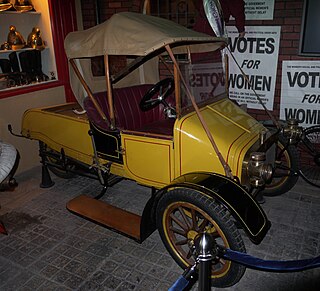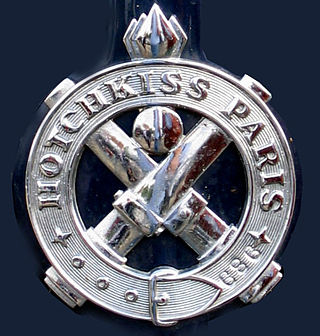

The GWK was a British car made in Maidenhead, Berkshire, between 1911 and 1931. It got its name from its founders, Arthur Grice, J. Talfourd Wood, and C.M. Keiller. [1] The cars were unusual in using a friction drive system. [2]


The GWK was a British car made in Maidenhead, Berkshire, between 1911 and 1931. It got its name from its founders, Arthur Grice, J. Talfourd Wood, and C.M. Keiller. [1] The cars were unusual in using a friction drive system. [2]
The prototype was made in a stable in Beckenham, Kent, [1] and used a Coventry-Simplex engine, rear-mounted. The drive system involved the engine, which was mounted across the chassis, turning a disc on which a wheel could be moved from the periphery to the centre. Top speed was with the driven wheel furthest from the centre and reverse was obtained by moving it past the centre. A few examples were sold before the company moved to Datchet, Buckinghamshire in 1912. [1]
Proper production now started still using a water-cooled, Coventry-Simplex twin-cylinder engine of 1069 cc. [3] 1,045 of the two-seat cars were made before the outbreak of World War 1 and a move to war work; this first stage of car production ended in mid-1915. [3] A move was also made to the larger Cordwallis Works in Maidenhead in 1914. During the war the company was run by Grice as his partners were in the army.
At the 1913 A.C.U. Six-Day trial, a GWK was one of three cars to finish (out of twelve starters), and it won the Gold medal in the four-wheel class. [3]
Grice left the company in 1920 to start the unsuccessful Unit car company leaving Wood and Keiller in charge. [4] They re-introduced the pre-war model, now called the Type E, and a further 82 were made largely from left over parts. A new model, the Type F was introduced in 1919 and was front-engined with a 1368 cc four-cylinder engine, still by Coventry-Simplex, with shaft drive to the friction disc at the rear. It was not a good seller partly because of the noise from the transmission; the power of the larger engine was more than the friction drive design could accommodate. [3] The Type H overcame most of the drive line problems but suffered from the reputation of its predecessor. About 1,700 of the Types F and H were made between 1919 and 1926.
The company had not given up on the rear-engined idea and a new car, the Type J, appeared in 1922 but only a few were sold. It had a bonnet and radiator very similar to the front-engined cars. The final car, the type G of 1930 was also rear-engined, with the engine behind the rear axle, only a few were made.
GWK's greatest days were before World War 1 and after 1918 financial success eluded them. They went into temporary liquidation in 1922 [1] and Wood and Keiller left but Grice returned in 1923. No cars seem to have been made between 1926 and 1930 and very few of the Type G were produced. The company finally closed in 1931 with the Cordwallis factory being used by Streamline Cars Ltd and later Marendaz.
GWK also sold an imported Belgian Impéria car between 1924 and 1928 as the British Imperia. There were plans to build the Imperia at Maidenhead but these came to nothing.

Morgan Motor Company Limited is a British motor car manufacturer owned by Italian investment group Investindustrial. It was founded in 1910 by Henry Frederick Stanley Morgan. Morgan is based in Malvern Link, an area of Malvern, and employs approximately 220 people. Morgan produce 850 cars per year, all assembled by hand. The waiting list for a car is approximately six months, but it has sometimes been as long as ten years.
The Adamson was an English car manufactured in Enfield, Middlesex, from 1912 to 1925. It was designed by Reginald Barton Adamson at the premises of the family haulage contract business.
Coventry Victor was a British motorcycle and car manufacturer. Originally Morton & Weaver, a proprietary engine manufacturer in Hillfields, Coventry, founded in 1904, the company changed its name to Coventry Victor Motors in 1911. The company closed in 1971.

Coventry Climax was a British forklift truck, fire pump, racing, and other speciality engine manufacturer.

Singer Motors Limited was a British motor vehicle manufacturing business, originally a bicycle manufacturer founded as Singer & Co by George Singer, in 1874 in Coventry, England. Singer & Co's bicycle manufacture continued. From 1901 George Singer's Singer Motor Co made cars and commercial vehicles.
The Lanchester Motor Company Limited was a British car manufacturer in active trade between 1899 and 1955. Though the Lanchester Motor Company Limited is still registered as an active company and accounts are filed each year, the marque has been dormant since. As of 2014 it is marked as "non-trading".

Crouch Cars was a company founded by JWF Crouch in Coventry, England in 1912 which manufactured cars until 1928. It was located at first in Bishop Street moving in 1914 to Cook Street.

Marendaz cars were made in Brixton Road, London SW9, England from 1926 to 1932 and in Maidenhead, Berkshire, England from 1932 to 1936. They were sold as Marendaz Specials.
Wooler was a British manufacturer of motorcycles and automobiles, founded by engineer John Wooler in 1911 based in Alperton, Middlesex. The company became known for its unconventional designs which included several fore-and-aft twins, a vertical camshaft single cylinder machine, a transverse-four beam engine, and a transverse flat four. Most machines possessed Wooler's enduring design features of a petrol tank which extended past the steering head.

Hotchkiss were luxury cars made between 1903 and 1955 by the French company Hotchkiss et Cie in Saint-Denis, Paris. The badge for the marque showed a pair of crossed cannons, evoking the company's history as an arms manufacturer.

Coventry Premier Limited owned a British car and cyclecar manufacturing business based in Coventry from 1912 to 1923. It changed its name from Premier Cycles to Coventry Premier Ltd in November 1914.

The Ner-A-Car was a type of feet forwards motorcycle designed by Carl Neracher in 1918. It used an unusual steel-channel chassis, much like an automobile, and hub-center steering at the front wheel, making it 'nearly a car' in design. The Ner-A-Car was the most successful hub-center steering motorcycle ever produced, with sales far eclipsing earlier or later examples of this design, such as the Yamaha GTS1000 or Bimota Tesi. About 10,000 Neracars were manufactured in the United States by the Ner-A-Car Corporation, while around 6,500 are believed to have been produced in England under licence by the Sheffield-Simplex company between 1921 and 1926 under the Ner-A-Car name.

Ariel Motorcycles was a British maker of bicycles and then motorcycles in Bournbrook, Birmingham. It was an innovator in British motorcycling, part of the Ariel marque. The company was sold to BSA in 1951 but the brand survived until 1967. Influential Ariel designers included Val Page and Edward Turner. The last motorcycle-type vehicle to carry the Ariel name was a short-lived three-wheel tilting moped in 1970.

The GN was a British cyclecar made in London, between 1910 and 1925, The name derived from its founders, H.R. Godfrey and Archibald Frazer-Nash. Production ceased in 1923 but the company kept trading until 1925.

The LuLu cyclecar was produced by the Kearns Motor Truck Company in Beavertown, Snyder County, Pennsylvania from 1914 to 1915.

Douglas was a British motorcycle manufacturer from 1907 to 1957 based in Kingswood, Bristol, owned by the Douglas family, and especially known for its horizontally opposed twin cylinder engined bikes and as manufacturers of speedway machines. The company also built a range of cars between 1913 and 1922.
Grahame-White was an early British aircraft manufacturer, flying school and later manufacturer of cyclecars.
The Marlborough was a make of car sold on the British market between 1906 and 1926. For most of its life the cars were made by Malicet et Blin in France, but after World War I they were partially assembled (finished) in London and an increasing number of British parts used.

The Warren-Lambert Engineering Co. Ltd. was a British automobile manufacturer that was established from 1912 to 1922 in Richmond, then in Surrey. A. Warren Lambert, was an agent for Morgan cars in Putney which he also raced. In 1912 he designed and started to manufacture a two-seat four-wheel cyclecar from premises in Uxbridge Road, Shepherd's Bush. It was well received and around 25 cars a week were being made.

The Autocrat was a British car manufacturer operating from 1913 to 1926. The company operated from premises in the Balsall Heath area of Birmingham. Unusually for the time the company seems to have been run by two women, Ivy Rogers and Miss Howell.